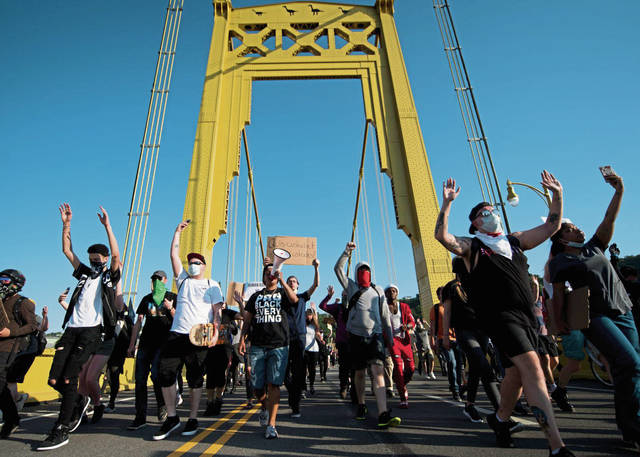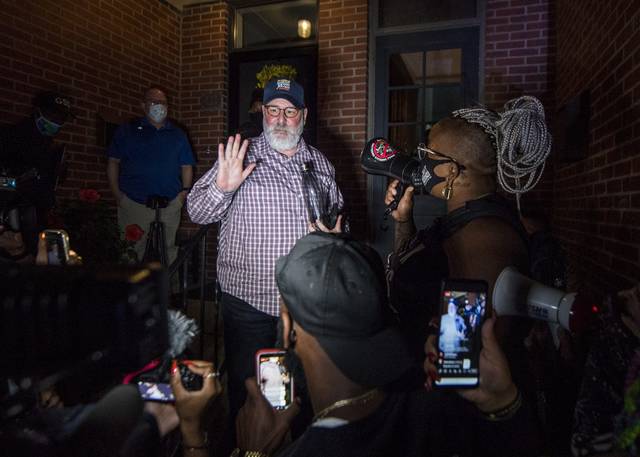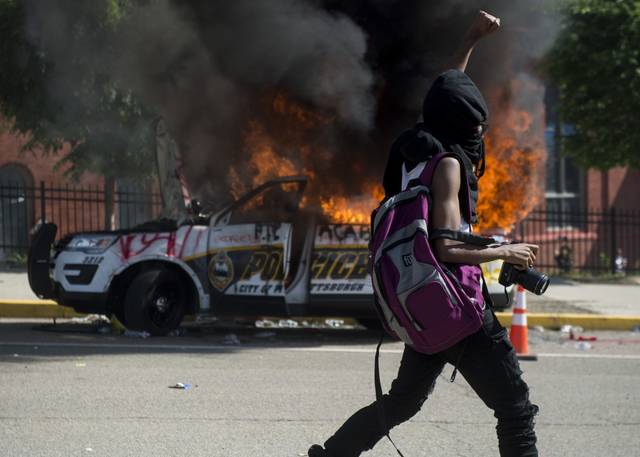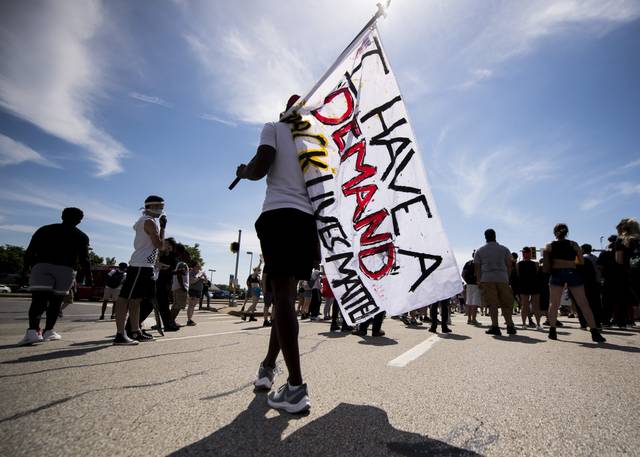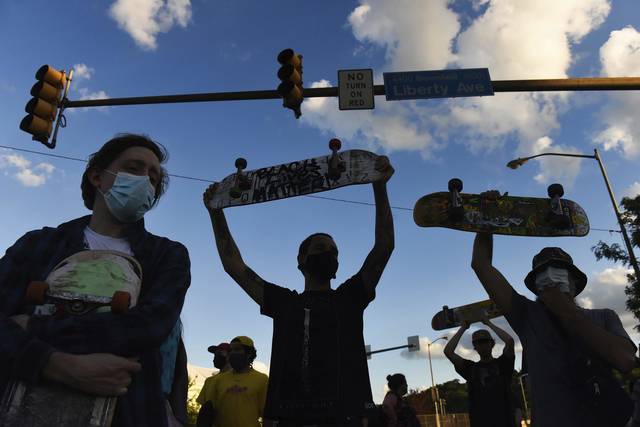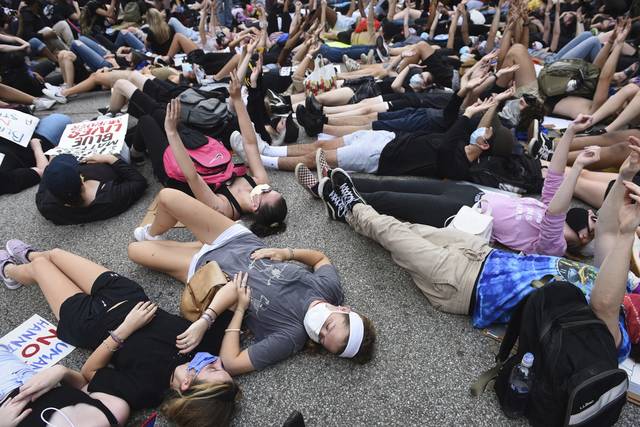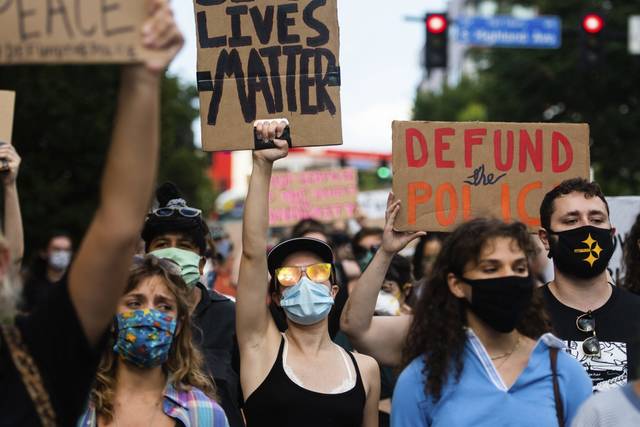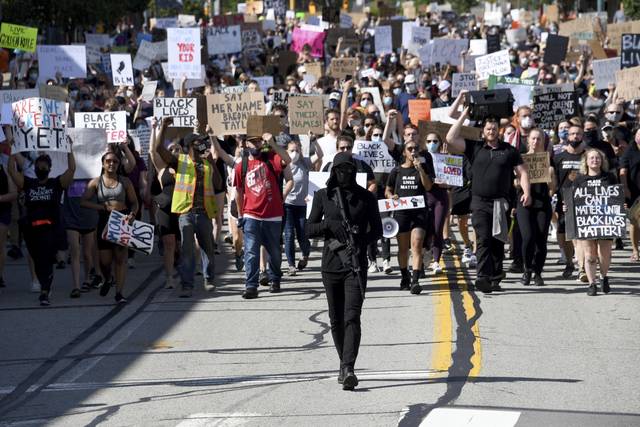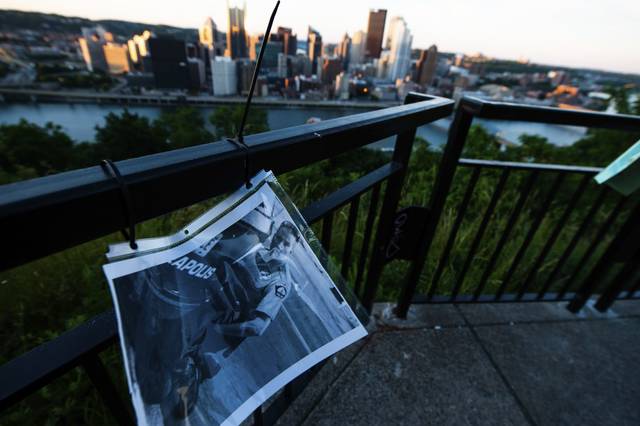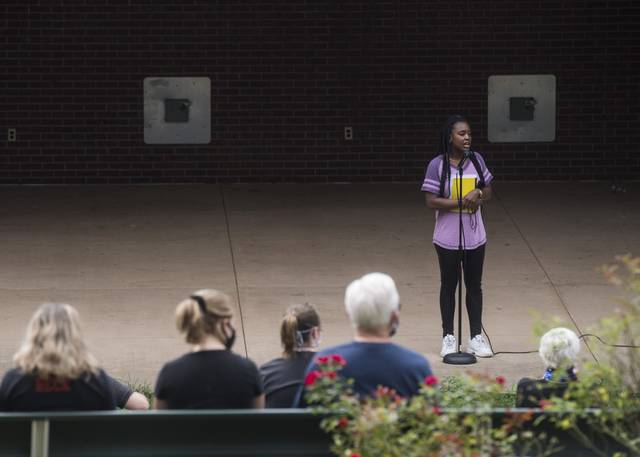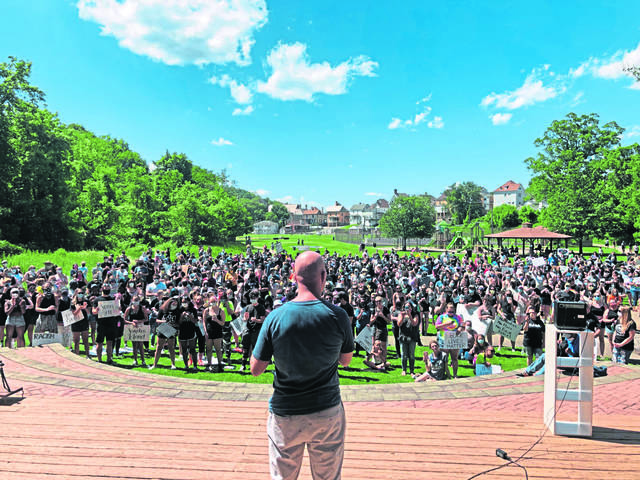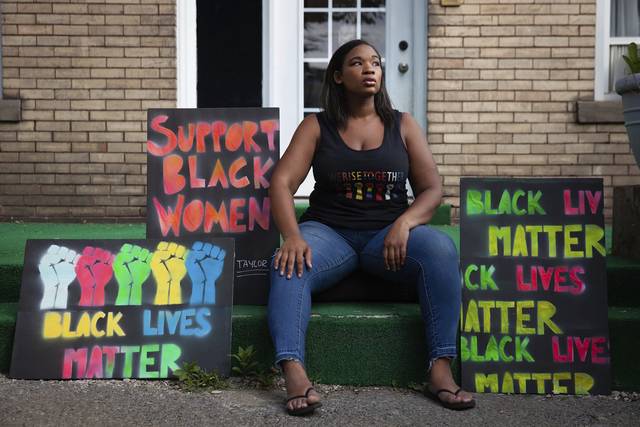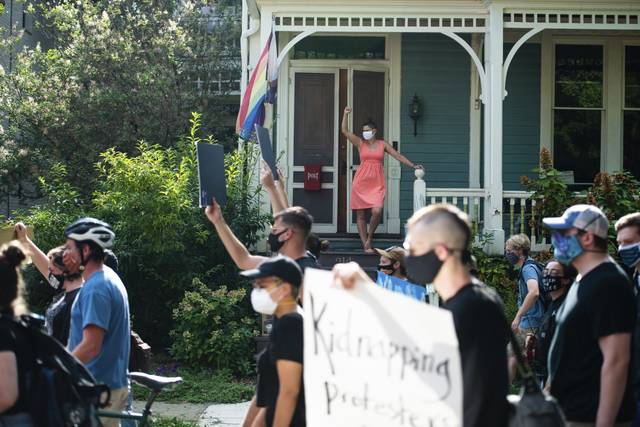A year after George Floyd's death, protesters reflect on what's changed in Western Pennsylvania
The year since George Floyd was killed by a former Minneapolis police officer has brought with it protests, anguish and, perhaps louder than anything, calls for change.
The year also has been one of realization for some.
“A lot of people are aware of something they weren’t aware of before,” said Yukie King, 32, who marched with Voice of Westmoreland and is running for Greensburg City Council. “It took an entire nation to get some semblance of justice for one man, one case. But people’s minds are changing. I hear it when I talk to people out knocking on doors in person.
“People are ready for racial justice.”
Subsequent protests that lasted through the summer began in big cities but soon touched smaller Western Pennsylvania towns such as Murrysville, Vandergrift, Irwin, O’Hara and Jeannette. Those smaller gatherings here remained peaceful.
A central element of the case that sparked outrage was the video of the officer forcefully restraining Floyd until he died. A bystander named Darnella Frazier, 17 at the time, took the video and posted it to Facebook, where it went viral.
Point Park University’s Mitchel Nickols, an adjunct professor of public engagement and organizational leadership, said the viral video made centuries-long mistreatment undeniable.
“I think that higher visibility was so important,” said Nickols, who consults with public schools and police departments on diversity and implicit bias. “But it must be followed with a whole lot of dialogue in those areas. I think sometimes people in predominantly white communities may not know how to start that conversation, so people like me are needed to start it.”
Nickols hopes those conversations will resume as society reopens from the pandemic.
Aaron Moore’s peaceful Black Lives Matter march in New Kensington last year drew more than 300 people. Moore said it is imperative the conversation continue, but he fears it is sputtering.
“In my opinion, nothing has changed. I see the money New Kensington, Arnold and Lower Burrell are getting from relief funds, and none of it is going to community engagement or police-community relations,” said Moore, 49, of Arnold.
Moore and Nickols say it will remain easy for many to turn away from the issues haunting Black and brown people as long as their history is given short shrift in public schools. Issues such as reconstruction, Jim Crow, segregation, redlining and other barriers Blacks faced, as well as the contributions they made, must be included in classroom curricula, they say.
The death of Floyd in police hands, starkly presented to a nation on edge amid a public health crisis, set into motion sweeping cultural forces that had long been simmering.
“The mistreatment of Black men and Black women by police is something that has been going on for decades and decades. But George Floyd’s murder was a tipping point for America in a way that it peeled back decades of mistreatment and brought it to the forefront for Americans to see directly,” said Jerry Dickinson, a constitutional law professor at the University of Pittsburgh.
“As a result of that, I think America was forced to reckon with that reality. I think George Floyd’s murder was a moral reckoning for the entire country, and we saw a massive movement all across the United States calling for change.”
In fact, before May 25, 2020, the social justice movement seemingly had ground to a halt, according to Pittsburgh Women’s March organizer Tracy Baton, a McKeesport-area social worker.
“We were in a place where people were really expressing that they felt dead in the water,” said Baton. “A big cross-section of community organizers throughout Pittsburgh were feeling like we can’t do anything, that we were blocked by the pandemic and blocked by our own fears. That day (of Floyd’s murder) made people say ‘OK, maybe I can’t do what I did before, but I have to figure something else out to push forward and create change from where I am.’ ”
‘What collective activism looks like’
Tanisha Long, founder of Black Lives Matter-Pittsburgh and Southwest PA, got out and pushed forward. Long said many people were awakened to what racial injustice is, especially with the video of what happened to Floyd at the hands of the Minneapolis police. Former officer Derek Chauvin was convicted of murder in Floyd’s death.
“If anything came from this, it’s that we learned as a country what collective activism looks like and what happens when we come together and what a breaking point looks like,” said Long. “We kind of got the ear of America, and a lot of people have found that they can demand things from people in charge and that they can get them done.”
Pittsburgh police Chief Scott Schubert issued his own strong words hours after the verdict, repeating statements he made just days after Floyd’s death: “As police officers, we have a fundamental duty to care for and safeguard everyone and anyone in our custody. That did not occur. A man was deprived of his life, a family was deprived of their loved one, a community was deprived of their faith in the people who are entrusted to keep them safe,” he wrote.
“I simply cannot comprehend the actions of the officers or their lack of moral courage and duty to intervene and stop the action before it was too late,” he said on May 29, 2020.
He says he stands by those words.
“To see a person die in front of your eyes who’s asking for help … it wasn’t right,” Schubert said last week.
Baton, who is on the board of Pittsburgh’s Black Political Empowerment Project, said the organization immediately started engaging voters in the months before the November election on local violence issues.
“People were saying unless (Joe Biden) wins the November election, we’ll just have more of this,” she said. “A lot of people wanted to make sure George Floyd’s life was not lost in vain, and that became a collective undertaking that is really powerful.”
Baton said she believes that same energy carried through to the Democratic mayoral primary in Pittsburgh this month.
“People wanted to see things be different and saw that having more of the same just wasn’t going to do,” she said.
Long said the desire for change that gained momentum in the wake of Floyd’s death had a direct impact on the outcome of the Pittsburgh mayor’s race.
“His (Peduto’s) officers threw a person who was helping with the protests into an unmarked van,” Long said of an August incident in the city’s Oakland neighborhood. “ He could have taken accountability for his actions during the protests. Instead, he doubled down.
“I think he really did not think about the Black Pittsburgh that he claims he was supporting. He would not have called us anarchists. If you treat people like that, they’re going to pick somebody else to take your place.”
State Rep. Ed Gainey prevailed over Peduto in the primary and likely will be elected mayor in November. He is in line to be Pittsburgh’s first Black mayor.
But Baton said there also needs to be reform throughout Allegheny County.
“It is the county police and the patchwork of little trained police departments that I see as the next real problem that we have to solve,” said Baton. “Black bodies have to be safe in Allegheny County, not just Pittsburgh.”
Dickinson acknowledges there is still “unfinished business” when it comes to racial equality in Pittsburgh. He points to statistics indicating racial disparities still pervade in “every single aspect of law enforcement in Pittsburgh,” including numbers showing nearly 4,000 Black men were arrested in the city in 2020 while only about 1,700 white men were arrested.
However, he said, a movement has taken hold in the past year that is starting to push the policy agenda and change laws for the better.
“I think that here in Pittsburgh we have a really great opportunity to make Pittsburgh a world-class city of racial equality,” said Dickinson, who is running for Congress in 2022, his second run against Rep. Mike Doyle for the Democratic nomination. “The murder of George Floyd has now sparked a certain type of energy within this city to now become better and to reach for a vision of racial equality that we’ve never seen before.”
Pittsburgh police chief: ‘looking to improve’
It’s something that Schubert says he wants to see as well.
“I think we’ve actually been very progressive over the years,” he said. “We still have a lot of work to do, but so does everybody else — and I’m talking not just law enforcement.”
He pointed to the bureau’s policy changes, adoption of the “Eight Can’t Wait” campaign and creation of the Office of Safety, Accountability and Resiliency, which works to find and implement new policies and best practices. The city also has created the Office of Community Health and Safety, which brings together Public Safety and social services to get the right responders to the right calls.
“We’re always looking to do better,” Schubert said. “I think any organization, no matter who you are, should always be striving to do better.”
Sometimes that includes outside investigations: The city’s Office of Municipal Investigations and the independent Citizen Police Review Board both continue their respective investigations into a June 1 protest in East Liberty that ended in a violent clash between police and protesters. Two days earlier, a Downtown protest erupted in violence, and a police vehicle was set ablaze.
Schubert declined to talk about the clash between law enforcement and protesters in East Liberty that day, citing several lawsuits that have been filed against the city and police for injuries suffered that day.
The aftermath of that protest drew particular ire from activists and supporters who contended that officers escalated the situation needlessly and then tried to backtrack on their use of force. Schubert declined to comment on the communication issues and on whether or not he stood by the level of force used, again citing the ongoing civil litigation.
It is department policy not to comment on pending litigation. The police actions that night are also under investigation by the city’s Office of Municipal Investigations and the independent Citizen Police Review Board.
Schubert said he’d like to “go through why different things were done” once he can speak freely about the events that left a slew of protesters injured by tear gas and less-lethal projectiles. He said the bureau is “looking at it, seeing what we did and always learning from it.”
“If you’re not always looking to improve, maybe it’s time to leave,” he said.
Despite the violent clashes with protesters, Schubert has marched alongside demonstrators and taken a knee with them when invited to.
“I did it for all minorities who have experienced decades — centuries, actually — of systemic racism and discrimination. I did it for all of those people around me on Friday, peaceful protesters who want real and meaningful change, not ill-conceived, knee-jerk reactions,” he said at the time.
He has also been vocal when others have been mum, most notably in the aftermath former officer Chauvin’s conviction in Floyd’s death last month. The head of the union representing Pittsburgh police officers declined to comment, indicating it would be “inappropriate” to do so on a situation not involving Pittsburgh.
Schubert said he sent his thoughts after Floyd’s death and after the verdict to his officers first, “to let them know what I thought of it.”
“I have to always recognize that I represent everybody, not just the police department and not just the community,” he said. “I represent everybody — the police officers and the community.”
Reforms in Pittsburgh
Just weeks after George Floyd died in police custody, Pittsburgh Mayor Bill Peduto announced the creation of a task force meant to identify and tackle the most pressing issues diving law enforcement and the communities they police.
The goal, Peduto said at the time, was to have a diverse selection of voices and input in the process, and the slate of task force members included some activists who had been at the forefront of the Black Lives Matter protests.
In October, the task force issued its recommendations – a list of issues, points of contention and ideas. There were eight points of focus:
- Eliminating racial disparities
- Officer wellness
- Reimagining policing
- Recruitment, training, education and hiring
- Relations with Pittsburgh’s Fraternal Order of Police
- Transparency and accountability
- Use of force changes Use of tear gas, rubber bullets, flash-bang devices and other less lethal methods of crowd control
The lengthy and comprehensive report remains online.
About a month later, task force members pressed city officials on what they saw as a lack of movement on the issues.
The bureau of police has since created an online dashboard that lists the task force recommendations, the steps they have already taken, the steps they plan to take and the anticipated timelines.
There are dozens of recommendations, some of which the bureau had implemented before the task force was formed – like providing searchable data through the Burgh’s Eye View applications and its annual report.
Realizing many of the recommendations hinges on the implementation of a new report management system, which officials have said will allow for a more comprehensive look at all police activity – not just aggregate data.
Public safety officials have estimated it will take about a year to launch that new report management system.
After the task force was formed, the city enacted reforms including a ban on chokeholds, a ban on purchasing surplus military equipment by police and creation of a Stop the Violence Fund to use money in the police budget for social services.
Other examples of works in progress include the bureau’s Community Engagement Office working to publicize the 211 and 311 call systems, which allow city residents to call for social services and non-emergency services without calling 911 and thus drawing a police response. Under the category of cadet training, officials said they are working to expand the training academy curriculum to include lessons from more experts as well as training on religious, racial and other discriminatory profiling.
Remove the ads from your TribLIVE reading experience but still support the journalists who create the content with TribLIVE Ad-Free.

